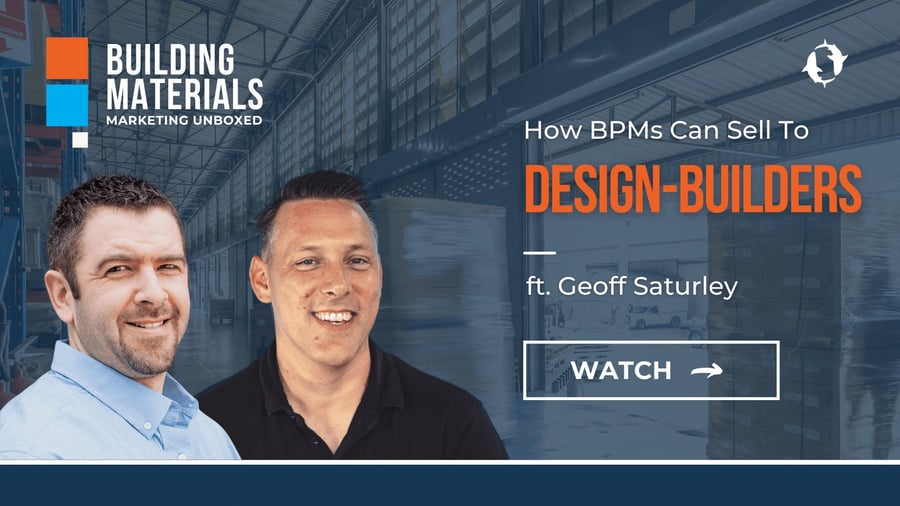Why Manufacturers Should Solve For Design-and-Build Contractors
Danielle Fauteaux

Design and build contractors are an entirely separate buyer persona for building products compare to the stereotypical builder persona. They have different purchase motivations, a different process, and different challenges to overcome.
This means that your channel marketing strategy for builders or contractors may not cut it to attract and convert design-build firms into loyal customers.
What is a Design-Build Contractor?
A Design-Build or Design-and-Build company is organized such that they handle both primary phases of a construction project: the design phase and the build phase. This means these firms employ either fully licensed architects or at least architectural drafters as well as interior designers. They also employee a team of construction experts and often do less subcontracting.
How Construction Products Are Specified in Design-Build Projects
Because the primary team is all under one roof and truly on the same team, the way construction products are specified is slightly different.
The client will meet with the lead designer and construction manager through the design phase which ensures each party is on the same page. This format also allows for the construction manager to bring key insights to the designer's ideas. The team members form a working relationship that carries over into each new project they work on together, rather than unacquainted architects and builders squabbling over design changes before breaking ground and during the build phase. This can significantly reduce the trust gap, decrease the number of change orders required between design and construction, and decrease channel wide frustrations.
As a bonus to you, the manufacturer, the potential of being value-engineered out of a design is much lower when you are supplier materials to design-build firms. It is still possible due to unforeseen construction challenges once on-site, but value engineering is much less likely to occur because of a mere difference of opinion or personal preference of the installer.
Further, design-and-build firms regularly employ a purchaser or procurement team, who are the ones who actually order and secure the building materials and deal with any hassles requiring assistance from your customer service team. This means they have a say in what manufacturers are purchased from, primarily with regard to convenience and customer delight factors.
The collaborative design-build approach bridges several gaps that are ever widening in the traditional design-bid-build construction methodology, which is why design-build is steadily increasing market share. All portions of the project cost are accounted for under one roof as well, which is a card in the hand of luxury materials and finishes manufacturers who are often specified in the traditional design, but then value-engineered out and replaced by a slightly less expensive alternative after the bid phase.
How to Market and Sell to Design and Build Customers
The basic premise of marketing and selling to design and build customers is the same as selling to builders or selling to contractors: make their lives easier and help them increase profitability. You can do this by provided resources, tools, and assistance that enable them to overcome the top challenges they face.
1. Solving for Changing Materials & Labor Costs
In order to provide accurate total project estimates and account for realistic materials allowances, design-build teams need real time pricing for your products. As a manufacturer, we recognize it can be a challenge to centralize this information for customers and partners because of your channel pricing strategy.
A couple of solutions could implemented, still:
- Have different direct and indirect partners sell to different buyer persona categories.
- Use smart-content features on the HubSpot CMS to display variable pricing to different buyer personas on your website based marketing content.
- Establish clear "recommended retail pricing" to your channel partners that is consistent with the price listed on your website.
Working with the right channel management agency is a great way to align your marketing messaging and sales enablement resources to solve for design-build firm's challenges.
2. Finding Qualified Construction Labor
Not only is it proving difficult to hire full-time construction workers, but it is also providing difficult to get on subcontractors schedules during the remodeling and construction boom happening in 2021. Partner with local speciality contractors to provide flat-rate installation or priority job completion options to help design-build firms decrease labor costs while still ensuring quality and timeliness of install. This could look like partnering with local electricians and providing a contractor directory on your own website so that your customers can find a suitable installer in a pinch.
Design-and-build contractors also need reliable customer support representatives at your company and within your distribution channel network to have deep construction and installation knowledge of your product in order to help them solve very specific problems. Providing in-depth installation videos on your website is step one toward achieving this.
3. Overcoming Lead Time Delays
Purchasers and procurement teams need real time availability and product quantity information. They also need assurance of future material availability, as their construction projects can take variable lengths of time to complete.
Help them overcome lead time delays due to unaccounted for out of stock items by giving them self service recommendations on your website to purchase similar products that would also work.
Add more value to your customers by allowing for pre-order reservations and providing regular updates about product availability and order fulfillment capabilities.
4. Becoming the Client's Trusted Advisor
While the previous challenges are more quantifiable, your channel marketing teams should also be providing support and resources that enable design-and-build teams to quickly bridge the client trust gap and become their trusted advisor throughout the entire project.
It's common for design-builders to see similarities between a courting and dating relationship likewise in the relationship between their team and the client. This means that your role is to be the match-maker that supports a positive outcome for everyone involved.
You can do this by centralizing product specification and use case information on your website so that your uninformed distribution partners and less informed dealer's reps are not adding friction to the design-build process. When you, the materials manufacturer, take ownership of this portion of the product research and specification process, you will enable your customers to gain as much knowledge as necessary about your product to become their client's trusted advisor and in turn, you increase brand trust with your customers too.
5. Improving Workflow Between the Design and Construction Project Manager
You have your list of top competitors for your specific material. Now, imagine being expected to have in mind all possible variations of hundreds of materials on the market to provide the best build outcome to a client.
The sheer volume of options on the market contributes to designers' and builders' tendency to stick with what they know and use the same brands and products in the majority of their projects. Thus, the best way to get on their radar and motivate them to change often has very little to do with your product itself, but rather much to do with how convenient you make it for them to choose your product.
Here are some ideas of how to streamline your customers' workflow:
- Develop Mood Boards: Pair your product with high market share products from other categories in mood boards for designers and architects. These Mood Boards make for great content in your partner portals and website resources and also make for great promotional content on Houzz, Facebook, Instagram, and Pinterest.
- Integrate with the design and construction management softwares they use. At the very least, structure your product specification information in easy to export and import format to increase the speed with which they can implement project management tasks.
- Develop self-service options for product ordering and order tracking. Much more on this topic here.
Don't Just Take It From Us
Above all else, make the Design-Build form look good to their clients.
Getting feedback directly from your customers is important to understanding how to provide superior customer service that enables your entire distribution channel, and especially the growing Design-and-Build segment, to sell more of your building materials, better.
It's time consuming and can be difficult to get feedback directly from your different customers. That's why we've taking it upon ourselves to interview actual people who fit your different customer profiles in Building Materials Marketing Unboxed.
Check out our episode with Geoff Saturely, the Pre-Construction Manager at a Design-Build Remodeling firm:



